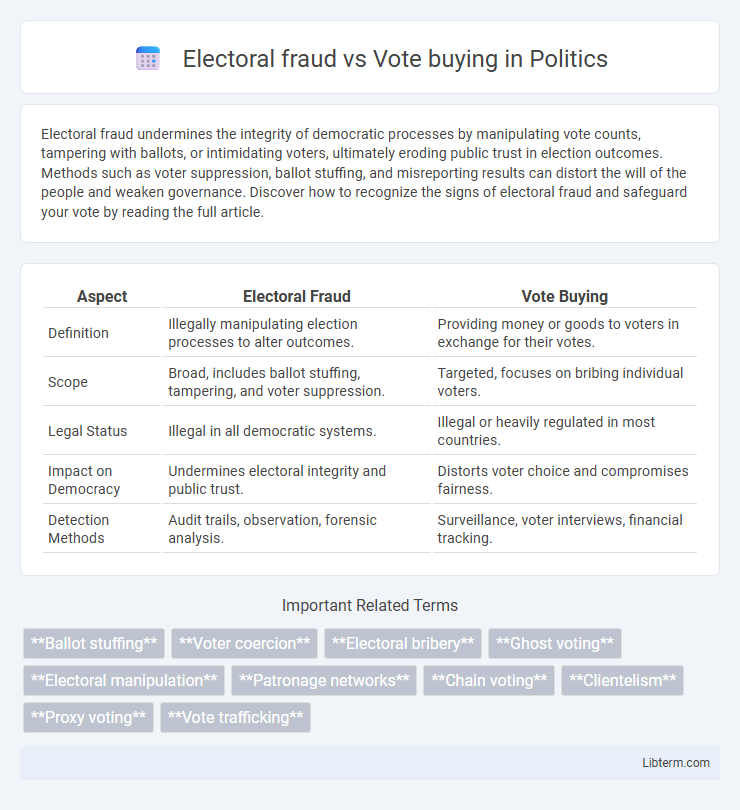Electoral fraud undermines the integrity of democratic processes by manipulating vote counts, tampering with ballots, or intimidating voters, ultimately eroding public trust in election outcomes. Methods such as voter suppression, ballot stuffing, and misreporting results can distort the will of the people and weaken governance. Discover how to recognize the signs of electoral fraud and safeguard your vote by reading the full article.
Table of Comparison
| Aspect | Electoral Fraud | Vote Buying |
|---|---|---|
| Definition | Illegally manipulating election processes to alter outcomes. | Providing money or goods to voters in exchange for their votes. |
| Scope | Broad, includes ballot stuffing, tampering, and voter suppression. | Targeted, focuses on bribing individual voters. |
| Legal Status | Illegal in all democratic systems. | Illegal or heavily regulated in most countries. |
| Impact on Democracy | Undermines electoral integrity and public trust. | Distorts voter choice and compromises fairness. |
| Detection Methods | Audit trails, observation, forensic analysis. | Surveillance, voter interviews, financial tracking. |
Introduction to Electoral Fraud and Vote Buying
Electoral fraud involves illegal manipulation of the voting process to alter election outcomes, including ballot stuffing, tampering with voter registration, and vote rigging. Vote buying is a specific form of electoral fraud where candidates or parties provide money or goods to voters in exchange for their votes, undermining the integrity of democratic elections. Both practices erode public trust, distort electoral competition, and weaken democratic institutions globally.
Defining Electoral Fraud: Scope and Types
Electoral fraud encompasses a wide range of illegal activities undermining the integrity of elections, including ballot stuffing, multiple voting, and tampering with vote counts. Vote buying, a specific form of electoral fraud, involves offering money or goods to voters in exchange for their votes, directly corrupting the democratic process. Understanding the scope of electoral fraud requires examining both overt actions like vote buying and covert manipulations such as misinformation campaigns and voter intimidation.
Understanding Vote Buying: Characteristics and Methods
Vote buying involves offering money, goods, or services to voters in exchange for their support, often targeting economically vulnerable populations to influence election outcomes. Common methods include direct cash payments, providing food or essential supplies, and promises of employment or favors conditional on voting for a particular candidate. Distinct from broader electoral fraud, vote buying specifically manipulates voter behavior through transactional incentives, undermining the integrity of democratic processes.
Key Differences Between Electoral Fraud and Vote Buying
Electoral fraud involves illegal interference with the election process, including activities such as ballot stuffing, tampering with results, and voter suppression, which undermine the integrity of the entire electoral system. Vote buying specifically refers to the act of offering money, goods, or services to voters in exchange for their votes, directly influencing voter behavior at an individual level. The key difference lies in scale and method: electoral fraud targets the election mechanism as a whole, whereas vote buying manipulates individual voter choices through bribery.
Historical Examples of Electoral Fraud
Historical examples of electoral fraud often involve tactics such as ballot stuffing, manipulation of voter rolls, and intimidation at polling stations, famously seen during the 1946 Italian elections and the 2004 Ukrainian presidential vote. Vote buying, a subset of electoral fraud, differs by directly exchanging money or goods to influence individual voters, notably observed in 19th-century U.S. elections and contemporary practices in parts of South Asia. These forms of corruption undermine democratic processes by distorting true voter intention and damaging electoral integrity globally.
Notable Cases of Vote Buying Worldwide
Notable cases of vote buying have been documented globally, from the 2010 Philippine elections where candidates distributed cash and goods to secure votes, to India's 2018 state elections marked by widespread distribution of money and gifts. In Brazil, the 2014 general elections highlighted organized vote buying schemes involving local politicians using direct financial incentives to influence voter behavior. These practices undermine democratic integrity by corrupting electoral outcomes, despite being distinct from broader electoral fraud tactics such as ballot stuffing or tampering with vote counts.
Motivations Behind Electoral Fraud and Vote Buying
Electoral fraud and vote buying both undermine democratic processes but differ in motivations: electoral fraud often stems from a desire to manipulate election outcomes illicitly to maintain power or marginalize opposition, while vote buying targets individual voters' economic vulnerabilities to secure immediate electoral support. Political parties engaging in electoral fraud prioritize long-term control and systemic advantage, whereas vote buying leverages short-term transactional gains by exploiting poverty and lack of political awareness. Understanding these motivations highlights the complex interplay between power retention strategies and socio-economic factors driving corrupt electoral behaviors.
The Impact on Democracy and Electoral Integrity
Electoral fraud, including tampering with voting machinery or ballot stuffing, directly undermines democratic processes by compromising the accuracy and legitimacy of election results. Vote buying, where money or gifts are exchanged for votes, distorts voter autonomy and creates unequal influence, weakening electoral integrity and public trust. Both practices erode democratic accountability and can lead to political instability by disenfranchising voters and skewing policy outcomes.
Legal Frameworks and Prevention Strategies
Electoral fraud encompasses a wide range of illegal activities that undermine the integrity of elections, such as ballot tampering, voter impersonation, and vote buying, which is specifically the act of exchanging money or goods for votes. Legal frameworks typically criminalize both practices, with strict penalties and regulatory measures to deter offenders and protect democratic processes. Prevention strategies include robust voter education, transparent electoral commissions, independent monitoring, and advanced technological safeguards like biometric voter identification to minimize fraud risks and enforce accountability.
Conclusion: Addressing Electoral Fraud and Vote Buying
Addressing electoral fraud and vote buying requires comprehensive legal reforms, robust enforcement mechanisms, and voter education to safeguard election integrity. Strengthening transparency in campaign finance and enhancing monitoring during elections deter manipulation and coercion. Empowering independent electoral bodies ensures accountability and fosters public trust in democratic processes.
Electoral fraud Infographic

 libterm.com
libterm.com